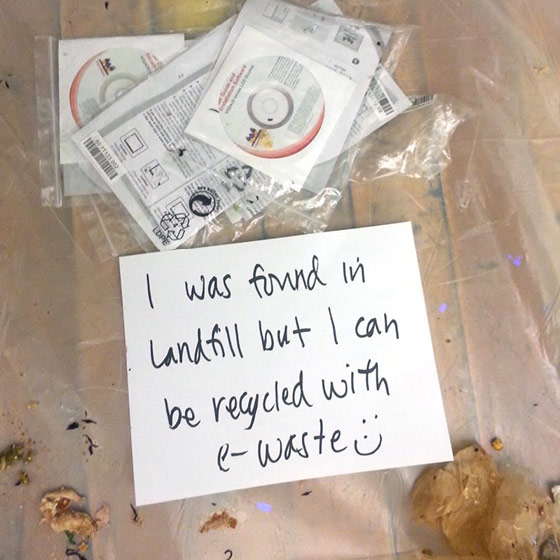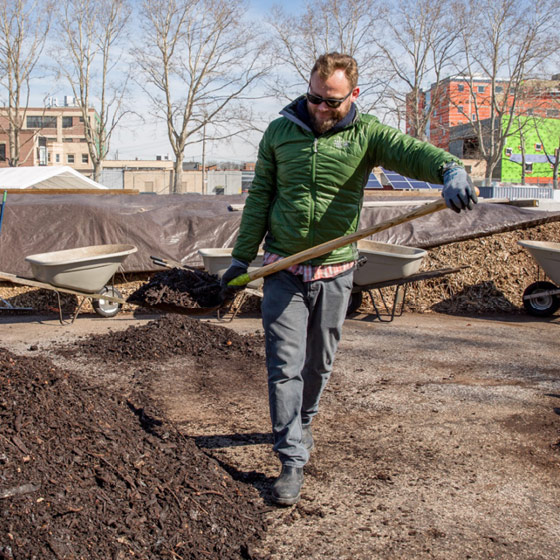We want to eliminate landfill-bound waste from our offices completely. We’re starting by reducing what we throw away.
In 2014 we implemented new processes and tools to accurately measure and report waste streams in six of our nine offices (additional offices will join in this effort in 2015). We have only a full year of data for our Berlin, Brooklyn, Hudson, and London offices. Next year we will be able to share even more information about waste from our offices around the world. We are also developing responsible disposal streams for all the items our company purchases as well as the ones brought into our facilities by employees, guests, and contractors.
Our waste: 2014
 E-Waste
E-Waste
Landfill Bottles and cans Paper and cardboard Compost
33%
Landfill
21%
Bottles and cans
21%
Paper and cardboard
24%
Compost
1%
E-Waste
*This represents data from the four offices where 81% of our employees work.
We reduced the waste each
employee sends to landfills by
21%
Our waste: waste to landfill per employee
43 lbs
2013
34 lbs
2014
Our waste: Berlin
 E-Waste
E-Waste
Landfill Bottles and cans Paper and cardboard Compost
18% Landfill
11% Bottles and cans
45% Paper and cardboard
26% Compost
0% E-Waste
Absolute waste diverted from the landfill in Berlin: 1,807 pounds
Our waste: Brooklyn
 1% E-Waste
1% E-Waste
Landfill Bottles and cans Paper and cardboard Compost
34% Landfill
23% Bottles and cans
21% Paper and cardboard
21% Compost
1% E-Waste
Absolute waste diverted from the landfill in Brooklyn: 26,713 pounds
Our waste: Hudson
 0% E-Waste
0% E-Waste
Landfill Bottles and cans Paper and cardboard Compost
25% Landfill
11% Bottles and cans
15% Paper and cardboard
49% Compost
1% E-Waste
Absolute waste diverted from the landfill in Hudson: 4,861 pounds
Our waveaste: London

0% Compost
0% E-Waste
Landfill Bottles and cans Paper and cardboard
52% Landfill
38% Bottles and cans
10% Paper and cardboard
0% Compost
0% E-Waste
Absolute waste diverted from the landfill in London: 756 pounds
Diving into our dumpsters
Understanding how physical goods flow in and out of our offices is the first step to reducing our waste footprint. We scrupulously review each of our purchases to account for the packaging we’re bringing in and develop end-of-life plans for when items eventually leave. Getting to zero waste requires everyone working in and passing through our offices to discard items according to our responsible disposal system, not an easy task.

In 2014, we conducted dumpster dives in Brooklyn and Berlin to understand what people are bringing into the office and what they are doing with their waste. In Brooklyn a group of employees, dressed in our trademark Etsy Waste and Recycling Team (e-WART) jumpsuits, sorted through a day’s worth of compost, recycling, and landfill waste. We spread the waste out onto large tarps, sorting and labeling the items in each stream.
We discovered that a lot of what we were sending to the landfill was either recyclable or compostable. Better education on what can be thrown away where and improved signage were logical next steps. We also added waste and recycling training programs to the employee orientation process and enlisted employees to do rotations as coordinators during high-waste occasions, such as company-wide meals.
Composting with the community
Our global offices compost more than 5,468 kilograms (12,054 pounds) of organic waste annually. Recycling nutrients back into the soils of our local food ecosystems, while diverting waste from landfills, is an important part of our move toward zero waste.

Composting in our Brooklyn office is a hands-on experience that is uniquely Etsy. Employees add their food scraps and bagasse plates from our biweekly company lunch to our handmade trash bins. Compost, along with our other waste streams, is weighed nightly on our dumpster scales. Twice a week different employees volunteer to deliver our food scraps to Red Hook Farm via a custom-built bicycle cart. Our efforts don’t end with the three-mile bike ride. Once at the farm we shovel our compost into the farm’s mounds, covering the newly added waste with mulch.
Red Hook Farm is not only an urban garden; it also serves as an educational facility, teaching at-risk youth the joys of growing their own food. This past year we contributed 3,773 kilograms (8,318 pounds) of compost to the mounds at Red Hook Community Farm. We also have robust composting programs at our Hudson, Berlin, and San Francisco offices with more implementing programs in 2015.